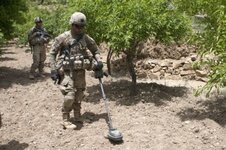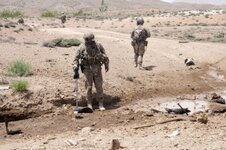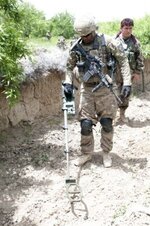Nugs Bunny
Hero Member
Metal Detector on Steroids The Minehound and Gizmo
As if digging pull tabs and rusty nails were not enough... and where do I get one of these?!?!



"It's a lot like the metal detectors you see men on the beach with, but on steroids"
The Minehound and Gizmo metal detectors, by Vallon, are "the current state-of-the-art technology dual sensor detectors capable of detecting command wires, non-metallic and low-metallic signature IEDs using ground penetrating radar," according their product description online. "In addition to GPR, the Minehound uses Vallon's advanced metal detector sensor, which is the same sensor used in Vallon's VMC-1 Gizmo detector to find both metallic and non-metallic threats."
DVIDS - News - C-IED teams locate roadside bombs using metal detectors on steroids
C-IED teams locate roadside bombs using metal detectors on steroids
Story by Sgt. Christopher McCullough
FORWARD OPERATING BASE LAGMAN, Afghanistan - The joint Afghan National Army-U.S. forces counter improvised explosive device team of seven soldiers walked down the dusty rural road in Shamulzai District, Afghanistan, ahead of their convoy; scanning the route with their eyes for subtle clues that might help them visually identify an IED hidden on the road. When they see nothing, they verify as much by sweeping the same area with their VMR-2 Minehound and VMC-1 Gizmo metal detectors in a slow precise manner before walking ahead.
"We walked a good four and a half (kilometers) in front of the whole convoy because we had just recently been hit with an IED on the route back (to Forward Operating Base Sweeney)," said Staff Sgt. Antonio Barajas, 3rd Platoon, 5th Battalion, 20th Infantry Regiment, Task Force 1st Squadron, 14th Cavalry Regiment, out of Joint Base Lewis-McChord, Wash. "All seven of us had Gizmos and Minehounds (and were) out there clearing the whole road so the rest of the convoy could make it back to FOB Sweeney safely."
"The Gizmo is just an easy (to use) metal detector used to identify metal or you can switch it to minerals," explained Barajas when asked to describe the two devices used that day.
"It's a lot like the metal detectors you see men on the beach with, but on steroids," said one of his soldiers, Pfc. Niko Williams, also from 3rd Platoon, 5-20 Infantry, Task Force 1-14 Cavalry.
The use of such gadgetry has been a blessing to both ANA and International Security Assistance Forces in Afghanistan. For Barajas and his team, the MineHound's ground penetrating radar enabled them to discover a secondary IED earlier in the day, prior to the IED strike on their convoy. That IED was only a hundred meters forward of the one that hit them. Without the MineHound, there stood a chance Barajas' team may have missed that roadside bomb.
The Minehound and Gizmo metal detectors, by Vallon, are "the current state-of-the-art technology dual sensor detectors capable of detecting command wires, non-metallic and low-metallic signature IEDs using ground penetrating radar," according their product description online. "In addition to GPR, the Minehound uses Vallon's advanced metal detector sensor, which is the same sensor used in Vallon's VMC-1 Gizmo detector to find both metallic and non-metallic threats."
The Vallon Company claims to have more than 2,000 Minehound detectors currently in use in Afghanistan. They, along with the Gizmo, have become an invaluable item in finding IEDs and weapons caches before they can be used against ANA or ISAF forces.
The use of the Minehound and Gizmo detectors started with combat engineers and explosive ordnance disposal personnel, but they are now issued to non-EOD units such as Battle Company 5-20 Infantry to aid in the discovery of IEDs and weapons caches.
Since the onset of the Afghan War in 2001, homemade bombs have increasingly become the insurgent's weapon of choice here in Afghanistan and certainly their most effective weapon. Almost 60 percent of all coalition forces wounded or killed in Afghanistan since the start of the war in 2001 have been due to IEDs, according to a May 2011 report from the Joint Improvised Explosive Device Defeat Organization, a U.S. Department of Defense organization located in Washington D.C.
To complicate matters, insurgents in Afghanistan have been increasingly constructing IEDs to circumvent simple metal detectors. Some IEDs contain rudimentary materials such as wooden boards, foam rubber, and plastic containers. The finished product contains very little metal making it difficult for a traditional metal detector to pick up, but not for the Minehound with its ground penetrating radar.
Increasingly compact, collapsible, light-weight metal detectors, such as the MineHound and Gizmo, are finding IEDs with more frequency than ever before, all of which has reduced the number of injuries or deaths to Afghan civilians, ANA and ISAF troops. In the hands of an infantry platoon, or similar-type unit, they are also being used to find weapons caches which often provide the insurgency with ample arms to fight for weeks or months.
"In the orchards (the Minehound and Gizmo are) good because that's where they often hide the caches," said Barajas. "So far we've found two caches with the Gizmo and Minehounds, and also with the ANA helping us out with their resources."
Without doubt, improved technological devices such as the VMR-2 Minehound and VMC-1 Gizmo metal detectors are helping coalition troops across Afghanistan.
"It helps a lot when we're in the orchards or going through the towns when we use the Gizmos and Minehounds because it also allows if something does get missed by sight it will pick it up," said Williams. "That's what makes the Gizmo and Mine Hound so important," said Williams. "It helps make sure people are not being taken out of the fight … (that) you're keeping them in," said Williams.

Pfc. Nikko Williams, 3rd Platoon, Battle Company, 5th Battalion 20th Infantry Regiment, Task Force 1st Squadron 14th Cavalry Regiment, uses a Minehound to search for weapons caches in an orchard outside the village of Sowkray Tangay, Afghanistan, May 7, 2012. The Minehound is a handheld detector that uses ground penetrating radar and metal detection technology which gives it the ability to detect deep buried, low metallic threats such as mines and caches.

Staff Sgt. Anthony Shaw (left), 787th Ordnance Company, 3rd Ordnance Battalion, uses a VMR-2 MineHound to search for possible secondary improvised explosive devices following an earlier incident. The MineHound's ground penetrating radar allows operators to locate IEDs that may otherwise not be found by the naked eye.

Staff Sgt. Antonio Barajas, 3rd Platoon, Battle Company, 5th Battalion 20th Infantry Regiment, Task Force 1st Squadron 14th Cavalry Regiment, uses a Gizmo to search for weapons caches in an orchard outside the village of Sowkray Tangay, Afghanistan, May 7, 2012. The Gizmo is a handheld metal detector that uses metal detection technology to locate metallic threats such as mines and caches.
As if digging pull tabs and rusty nails were not enough... and where do I get one of these?!?!




"It's a lot like the metal detectors you see men on the beach with, but on steroids"
The Minehound and Gizmo metal detectors, by Vallon, are "the current state-of-the-art technology dual sensor detectors capable of detecting command wires, non-metallic and low-metallic signature IEDs using ground penetrating radar," according their product description online. "In addition to GPR, the Minehound uses Vallon's advanced metal detector sensor, which is the same sensor used in Vallon's VMC-1 Gizmo detector to find both metallic and non-metallic threats."
DVIDS - News - C-IED teams locate roadside bombs using metal detectors on steroids
C-IED teams locate roadside bombs using metal detectors on steroids
Story by Sgt. Christopher McCullough
FORWARD OPERATING BASE LAGMAN, Afghanistan - The joint Afghan National Army-U.S. forces counter improvised explosive device team of seven soldiers walked down the dusty rural road in Shamulzai District, Afghanistan, ahead of their convoy; scanning the route with their eyes for subtle clues that might help them visually identify an IED hidden on the road. When they see nothing, they verify as much by sweeping the same area with their VMR-2 Minehound and VMC-1 Gizmo metal detectors in a slow precise manner before walking ahead.
"We walked a good four and a half (kilometers) in front of the whole convoy because we had just recently been hit with an IED on the route back (to Forward Operating Base Sweeney)," said Staff Sgt. Antonio Barajas, 3rd Platoon, 5th Battalion, 20th Infantry Regiment, Task Force 1st Squadron, 14th Cavalry Regiment, out of Joint Base Lewis-McChord, Wash. "All seven of us had Gizmos and Minehounds (and were) out there clearing the whole road so the rest of the convoy could make it back to FOB Sweeney safely."
"The Gizmo is just an easy (to use) metal detector used to identify metal or you can switch it to minerals," explained Barajas when asked to describe the two devices used that day.
"It's a lot like the metal detectors you see men on the beach with, but on steroids," said one of his soldiers, Pfc. Niko Williams, also from 3rd Platoon, 5-20 Infantry, Task Force 1-14 Cavalry.
The use of such gadgetry has been a blessing to both ANA and International Security Assistance Forces in Afghanistan. For Barajas and his team, the MineHound's ground penetrating radar enabled them to discover a secondary IED earlier in the day, prior to the IED strike on their convoy. That IED was only a hundred meters forward of the one that hit them. Without the MineHound, there stood a chance Barajas' team may have missed that roadside bomb.
The Minehound and Gizmo metal detectors, by Vallon, are "the current state-of-the-art technology dual sensor detectors capable of detecting command wires, non-metallic and low-metallic signature IEDs using ground penetrating radar," according their product description online. "In addition to GPR, the Minehound uses Vallon's advanced metal detector sensor, which is the same sensor used in Vallon's VMC-1 Gizmo detector to find both metallic and non-metallic threats."
The Vallon Company claims to have more than 2,000 Minehound detectors currently in use in Afghanistan. They, along with the Gizmo, have become an invaluable item in finding IEDs and weapons caches before they can be used against ANA or ISAF forces.
The use of the Minehound and Gizmo detectors started with combat engineers and explosive ordnance disposal personnel, but they are now issued to non-EOD units such as Battle Company 5-20 Infantry to aid in the discovery of IEDs and weapons caches.
Since the onset of the Afghan War in 2001, homemade bombs have increasingly become the insurgent's weapon of choice here in Afghanistan and certainly their most effective weapon. Almost 60 percent of all coalition forces wounded or killed in Afghanistan since the start of the war in 2001 have been due to IEDs, according to a May 2011 report from the Joint Improvised Explosive Device Defeat Organization, a U.S. Department of Defense organization located in Washington D.C.
To complicate matters, insurgents in Afghanistan have been increasingly constructing IEDs to circumvent simple metal detectors. Some IEDs contain rudimentary materials such as wooden boards, foam rubber, and plastic containers. The finished product contains very little metal making it difficult for a traditional metal detector to pick up, but not for the Minehound with its ground penetrating radar.
Increasingly compact, collapsible, light-weight metal detectors, such as the MineHound and Gizmo, are finding IEDs with more frequency than ever before, all of which has reduced the number of injuries or deaths to Afghan civilians, ANA and ISAF troops. In the hands of an infantry platoon, or similar-type unit, they are also being used to find weapons caches which often provide the insurgency with ample arms to fight for weeks or months.
"In the orchards (the Minehound and Gizmo are) good because that's where they often hide the caches," said Barajas. "So far we've found two caches with the Gizmo and Minehounds, and also with the ANA helping us out with their resources."
Without doubt, improved technological devices such as the VMR-2 Minehound and VMC-1 Gizmo metal detectors are helping coalition troops across Afghanistan.
"It helps a lot when we're in the orchards or going through the towns when we use the Gizmos and Minehounds because it also allows if something does get missed by sight it will pick it up," said Williams. "That's what makes the Gizmo and Mine Hound so important," said Williams. "It helps make sure people are not being taken out of the fight … (that) you're keeping them in," said Williams.

Pfc. Nikko Williams, 3rd Platoon, Battle Company, 5th Battalion 20th Infantry Regiment, Task Force 1st Squadron 14th Cavalry Regiment, uses a Minehound to search for weapons caches in an orchard outside the village of Sowkray Tangay, Afghanistan, May 7, 2012. The Minehound is a handheld detector that uses ground penetrating radar and metal detection technology which gives it the ability to detect deep buried, low metallic threats such as mines and caches.

Staff Sgt. Anthony Shaw (left), 787th Ordnance Company, 3rd Ordnance Battalion, uses a VMR-2 MineHound to search for possible secondary improvised explosive devices following an earlier incident. The MineHound's ground penetrating radar allows operators to locate IEDs that may otherwise not be found by the naked eye.

Staff Sgt. Antonio Barajas, 3rd Platoon, Battle Company, 5th Battalion 20th Infantry Regiment, Task Force 1st Squadron 14th Cavalry Regiment, uses a Gizmo to search for weapons caches in an orchard outside the village of Sowkray Tangay, Afghanistan, May 7, 2012. The Gizmo is a handheld metal detector that uses metal detection technology to locate metallic threats such as mines and caches.
Last edited:
Upvote
0

